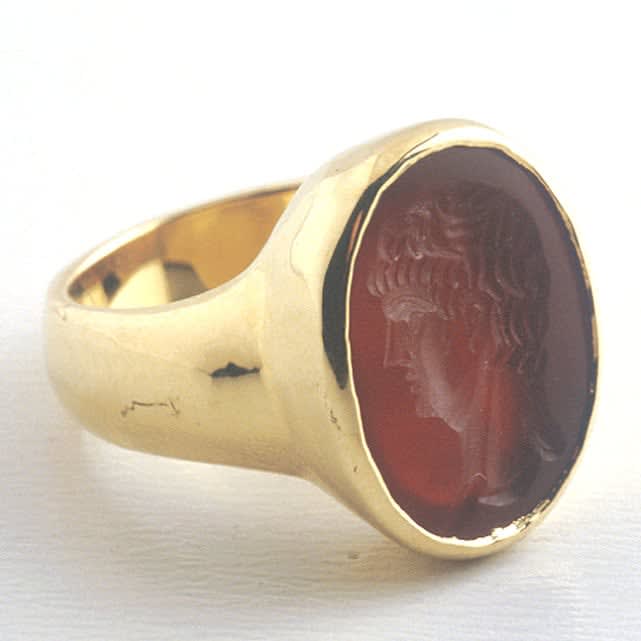Roman Carnelian Intaglio depicting a Roman Emperor, 100 CE - 200 CE
Carnelian-Gold
FJ.6377
This Intaglio is Set in an 18 Karat Gold Rin The art of glyptics, or carving on colored precious stones, is probably one of the oldest known to humanity. Intaglios,...
This Intaglio is Set in an 18 Karat Gold Rin
The art of glyptics, or carving on colored precious stones, is probably one of the oldest known to humanity. Intaglios, gems with an incised design, were made as early as the fourth and third millennia BC in Mesopotamia and the Aegean Islands. They display a virtuosity of execution that suggests an old and stable tradition rooted in the earliest centuries. The tools required for carving gems were simple: a wheel with a belt-drive and a set of drills. Abrasives were necessary since the minerals used were too hard for a "metal edge. A special difficulty of engraving intaglios, aside from their miniature size, was that the master had to work with a mirror-image in mind.
Royal portraiture was essentially confined in ancient Rome to coins, cameos and intaglios. Rings with engraved portraits of emperors were worn by members of the royal court, and occasionally given to particular favorites by the emperor himself. The elegant profile of this young emperor bears some resemblance to Nero. The deep relief of ancient engravers creates a lovely three-dimensional appearance, along with the natural coloration of the carnelian, combines to produce a dramatic effect-- suitable to an emperor of the Roman world.
The art of glyptics, or carving on colored precious stones, is probably one of the oldest known to humanity. Intaglios, gems with an incised design, were made as early as the fourth and third millennia BC in Mesopotamia and the Aegean Islands. They display a virtuosity of execution that suggests an old and stable tradition rooted in the earliest centuries. The tools required for carving gems were simple: a wheel with a belt-drive and a set of drills. Abrasives were necessary since the minerals used were too hard for a "metal edge. A special difficulty of engraving intaglios, aside from their miniature size, was that the master had to work with a mirror-image in mind.
Royal portraiture was essentially confined in ancient Rome to coins, cameos and intaglios. Rings with engraved portraits of emperors were worn by members of the royal court, and occasionally given to particular favorites by the emperor himself. The elegant profile of this young emperor bears some resemblance to Nero. The deep relief of ancient engravers creates a lovely three-dimensional appearance, along with the natural coloration of the carnelian, combines to produce a dramatic effect-- suitable to an emperor of the Roman world.
